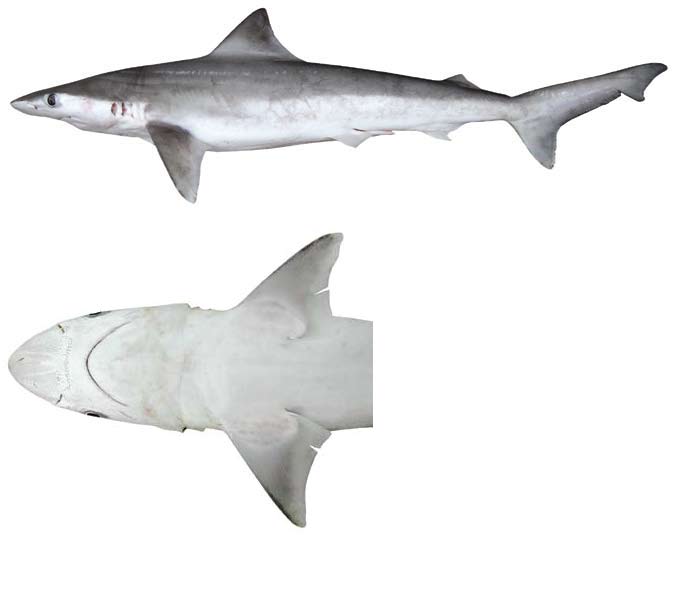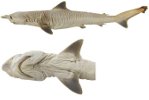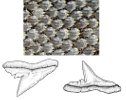Carcharhinus borneensis
(Bleeker, 1858)
Borneo shark
Classification: Elasmobranchii Carcharhiniformes Carcharhinidae
Reference of the original description
Twaalfde bijdrage tot de kennis der vischfauna van Borneo. Verhandelingen der Natuurkundige Vereeniging in Nederlandsch Indië, 5(7), 1–10
Twaalfde bijdrage tot de kennis der vischfauna van Borneo. Verhandelingen der Natuurkundige Vereeniging in Nederlandsch Indië, 5(7), 1–10
Image of the original description
No image in first description.
No image in first description.
Synonyms / new combinations and misspellings
Carcharias borneensis, Carcharias (Prionodon) borneensis, Carcharinus borneensis
Carcharias borneensis, Carcharias (Prionodon) borneensis, Carcharinus borneensis
Description :
Citation: Carcharhinus borneensis (Bleeker, 1858): In: Database of modern sharks, rays and chimaeras, www.shark-references.com, World Wide Web electronic publication, Version 01/2026
Please send your images of "Carcharhinus borneensis" to info@shark-references.com

Lateral view and ventral view of head of a fresh adult specimen of Carcharhinus borneensis IPPS BO428 (adult male 574 mm TL). In: White, W.T. & Last, P.R. & LIM, A.P.K. (2010): Rediscovery of the rare and endangered Borneo Shark Carcharhinus borneensis (Bleeker, 1858) (Carcharhiniformes: Carcharhinidae). CSIRO Marine and Atmospheric Research Paper, 32: 17-28

Lateral view and ventral view of head of a fresh adult specimen of Carcharhinus borneensis IPPS BO428 (adult male 574 mm TL). In: White, W.T. & Last, P.R. & LIM, A.P.K. (2010): Rediscovery of the rare and endangered Borneo Shark Carcharhinus borneensis (Bleeker, 1858) (Carcharhiniformes: Carcharhinidae). CSIRO Marine and Atmospheric Research Paper, 32: 17-28
Common names
 Tiburón de Borneo,
Tiburón de Borneo,  Requin tigre houareau,
Requin tigre houareau,  Requin-tigre houareau,
Requin-tigre houareau,  Borneo shark
Borneo shark
 Tiburón de Borneo,
Tiburón de Borneo,  Requin tigre houareau,
Requin tigre houareau,  Requin-tigre houareau,
Requin-tigre houareau,  Borneo shark
Borneo shark
Short Description
Diagnosis after White et al. [9059]: A small species of Carcharhinus with the following combination of characters: a long and pointed snout; slender body and tail; a row of enlarged hyomandibular pores (5–12) alongside each mouth corner; upper anterior teeth finely serrated with a single narrow, oblique cusp; distal edge deeply notched and with several cusplets; lower anterior teeth with narrower, similarly oblique cusps; no lateral cusplets; total tooth row counts 23–26/23–25, or 46–50; second dorsal-fin origin well posterior of anal-fin origin, about opposite or just anterior to anal-fin midbase, second dorsal-fin origin to anal-fin origin 2.2–4.1% TL, 0.4–0.9 times second dorsal-fin base; interdorsal space 20.7–22.7% TL; pelvic fins small, anterior margins 4.4–5.8% TL and 35–42% of pectoral anterior margin; first dorsal fin triangular, with nearly straight posterior margin, free rear tip about opposite pelvic-fin origins, length 14.5–17.6% TL, 1.8–2.4 times height, inner margin 1.9–2.8 in base; second dorsal fin much smaller than first, slightly smaller than anal fin; length 7.5–10.2% TL, base 2.0–3.1 times height; height 21–29% of first dorsal fin height; anal fin height 1.1–1.6 times second dorsal height, base 1.1–1.5 times second dorsal-fin base; total vertebral counts 117–121, monospondylous precaudal counts 33–36, diplospondylous precaudal counts 21–26, diplospondylous caudal counts 56–60, precaudal counts 57–63; colour slate-grey dorsally, whitish ventrally with waterline clearly demarcated along head and body, no distinct black markings on fins, pectoral fins and lower caudal lobe with whitish margins
Diagnosis after White et al. [9059]: A small species of Carcharhinus with the following combination of characters: a long and pointed snout; slender body and tail; a row of enlarged hyomandibular pores (5–12) alongside each mouth corner; upper anterior teeth finely serrated with a single narrow, oblique cusp; distal edge deeply notched and with several cusplets; lower anterior teeth with narrower, similarly oblique cusps; no lateral cusplets; total tooth row counts 23–26/23–25, or 46–50; second dorsal-fin origin well posterior of anal-fin origin, about opposite or just anterior to anal-fin midbase, second dorsal-fin origin to anal-fin origin 2.2–4.1% TL, 0.4–0.9 times second dorsal-fin base; interdorsal space 20.7–22.7% TL; pelvic fins small, anterior margins 4.4–5.8% TL and 35–42% of pectoral anterior margin; first dorsal fin triangular, with nearly straight posterior margin, free rear tip about opposite pelvic-fin origins, length 14.5–17.6% TL, 1.8–2.4 times height, inner margin 1.9–2.8 in base; second dorsal fin much smaller than first, slightly smaller than anal fin; length 7.5–10.2% TL, base 2.0–3.1 times height; height 21–29% of first dorsal fin height; anal fin height 1.1–1.6 times second dorsal height, base 1.1–1.5 times second dorsal-fin base; total vertebral counts 117–121, monospondylous precaudal counts 33–36, diplospondylous precaudal counts 21–26, diplospondylous caudal counts 56–60, precaudal counts 57–63; colour slate-grey dorsally, whitish ventrally with waterline clearly demarcated along head and body, no distinct black markings on fins, pectoral fins and lower caudal lobe with whitish margins
Distribution
Indo-West Pacific: Borneo and China. Possibly occurring in Java, Indonesia and the Philippines. Source: www.gbif.org
Indo-West Pacific: Borneo and China. Possibly occurring in Java, Indonesia and the Philippines. Source: www.gbif.org
Human uses
fisheries: subsistence fisheries
fisheries: subsistence fisheries
Habitat
demersal; marine
demersal; marine
Remarks
shark-references Species-ID=726;
shark-references Species-ID=726;




















